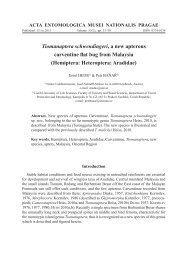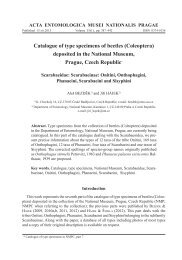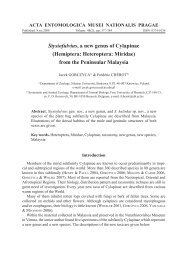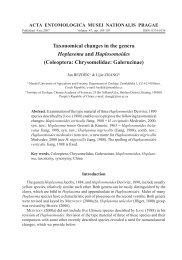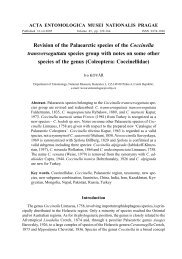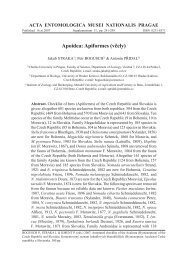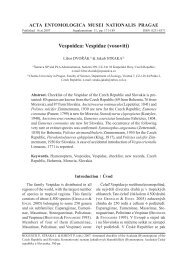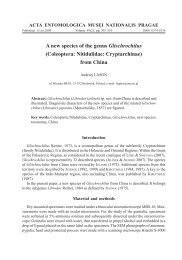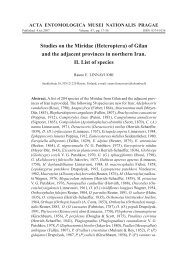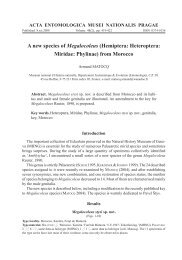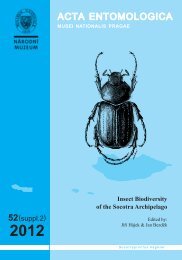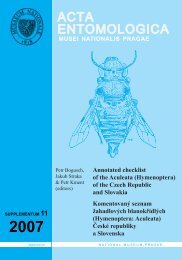Nomenclatural changes in the family Ciidae - Acta Entomologica ...
Nomenclatural changes in the family Ciidae - Acta Entomologica ...
Nomenclatural changes in the family Ciidae - Acta Entomologica ...
Create successful ePaper yourself
Turn your PDF publications into a flip-book with our unique Google optimized e-Paper software.
ACTA ENTOMOLOGICA MUSEI NATIONALIS PRAGAE<br />
Published 4.xii.2007 Volume 47, pp. 135-141 ISSN 0374-1036<br />
<strong>Nomenclatural</strong> <strong>changes</strong> <strong>in</strong> <strong>the</strong> <strong>family</strong> <strong>Ciidae</strong> (Coleoptera)<br />
Josef JELÍNEK<br />
Department of Entomology, National Museum, Kunratice 1, CZ-148 00 Praha 4, Czech Republic;<br />
e-mail: jj.nitidula@seznam.cz<br />
Abstract. Type specimens of <strong>the</strong> species Anobium micans Fabricius, 1792, A.<br />
nitidum Fabricius, 1792, and Kateretes castaneus Herbst, 1793, were revised<br />
and lectotypes designated. The follow<strong>in</strong>g new synonymies are established: Cis<br />
micans (Fabricius, 1792) = Cis hispidus (Paykull, 1798) syn. nov.; Sulcacis nitidus<br />
(Fabricius, 1792) comb. nov. = Sulcacis affi nis (Gyllenhal, 1827) syn. nov. Cis<br />
castaneus (Herbst, 1793) comb. nov. is <strong>the</strong> fi rst available name for Cis nitidus<br />
auct. (non Fabricius, 1792), Cis fusciclavis Nyholm, 1953, for Cis castaneus<br />
Mellié, 1849 (non Herbst, 1793), and Cis submicans Abeille de Perr<strong>in</strong>, 1874, for<br />
Cis micans auct. (non Fabricius, 1792).<br />
Genus-group name Eridaulus Thomson is available with <strong>the</strong> date 1859 and with<br />
<strong>the</strong> type species Cis comptus Gyllenhal, 1827, by orig<strong>in</strong>al designation. Valid name<br />
of Eridaulus sensu Thomson, 1863, is Xestocis Casey, 1898.<br />
Key words. Coleoptera, <strong>Ciidae</strong>, taxonomy, nomenclature, new synonymies, new<br />
comb<strong>in</strong>ations, Palaearctic region<br />
Introduction<br />
On prepar<strong>in</strong>g <strong>the</strong> catalogue of Palaearctic <strong>Ciidae</strong>, I came across several nomenclatural<br />
problems discussed <strong>in</strong> <strong>the</strong> present paper. Some of <strong>the</strong>m result from <strong>the</strong> revision of type<br />
specimens of <strong>the</strong> Fabrician species Anobium micans Fabricius, 1792, and Anobium nitidum<br />
Fabricius, 1792, <strong>the</strong> existence of which <strong>in</strong> <strong>the</strong> Zoological Museum of <strong>the</strong> Humboldt University,<br />
Berl<strong>in</strong> (abbreviated as ZMHB), was only recently established by MÜLLER et al. (2001). This<br />
discovery made it possible to resolve <strong>the</strong> long-last<strong>in</strong>g problem of <strong>the</strong> identity of Anobium<br />
nitidum Fabricius, 1792, but, on <strong>the</strong> o<strong>the</strong>r hand, revealed <strong>the</strong> mis<strong>in</strong>terpretation of Cis micans<br />
(Fabricius, 1792) by later authors, which leads to several unavoidable nomenclatural <strong>changes</strong><br />
proposed <strong>in</strong> this paper. Particular cases are discussed and a review of all result<strong>in</strong>g nomenclatural<br />
<strong>changes</strong> is given. Dat<strong>in</strong>g of <strong>the</strong> paper by MELLIÉ (1849) is based on <strong>the</strong> statements by<br />
ORLEDGE & BOOTH (2006).
136<br />
JELÍNEK: <strong>Nomenclatural</strong> <strong>changes</strong> <strong>in</strong> <strong>the</strong> <strong>family</strong> <strong>Ciidae</strong><br />
Results<br />
1. Eridaulus Thomson, 1859, and Eridaulus Thomson, 1863<br />
Problem of <strong>the</strong> genus-group name Eridaulus was commented on by LOHSE (1964) and<br />
LAWRENCE (1965). LOHSE (1964) po<strong>in</strong>ted out that Cis comptus Gyllenhal, 1827, was <strong>the</strong> type<br />
species of Eridaulus and that <strong>the</strong> name Eridaulus was later mis<strong>in</strong>terpreted and used as <strong>the</strong><br />
name for <strong>the</strong> group of species related to Cis nitidus, to which Cis comptus does not belong.<br />
On <strong>the</strong> contrary, LAWRENCE (1965: 280) summarized his op<strong>in</strong>ion <strong>in</strong> <strong>the</strong> follow<strong>in</strong>g two po<strong>in</strong>ts:<br />
(i) The genus Eridaulus Thomson, 1863, orig<strong>in</strong>ally <strong>in</strong>cluded two species: Anobium nitidum<br />
Fabricius, 1792, and Cis jacquemarti Mellié, 1849. (ii) The only worker to designate a type<br />
for Eridaulus was ABEILLE DE PERRIN (1874), who selected Cis comptus Gyllenhal, 1827. This<br />
species, however, was not orig<strong>in</strong>ally <strong>in</strong>cluded <strong>in</strong> <strong>the</strong> genus, and is <strong>the</strong>refore unavailable as a<br />
type. In <strong>the</strong> same work, ABEILLE DE PERRIN (1874) designated Cis nitidus as <strong>the</strong> type species<br />
of Entypus Redtenbacher. 1847, mak<strong>in</strong>g a similar error. Later, LAWRENCE (1971) designated<br />
Anobium nitidum Fabricius, 1792 [<strong>in</strong> fact Kateretes castaneus Herbst, 1793 misidentifi ed<br />
as Anobium nitidum Fabricius, 1792, see below] as <strong>the</strong> type species of Eridaulus Thomson,<br />
1863.<br />
However, LAWRENCE (1965) overlooked <strong>the</strong> fact that Thomson himself designated <strong>the</strong> type<br />
species of his new genera <strong>in</strong> <strong>the</strong> fi rst volume of his Skand<strong>in</strong>aviens Coleoptera (THOMSON<br />
1859). Thus his new genus-group names are available by <strong>in</strong>dication (ICZN 1999, Article<br />
12.2.5) with <strong>the</strong> date 1859, even though <strong>the</strong> formal descriptions of relevant genera appeared<br />
later <strong>in</strong> subsequent volumes of <strong>the</strong> book. In <strong>the</strong> fi rst volume THOMSON (1859: 91) designated<br />
Cis comptus Gyllenhal, 1827, as <strong>the</strong> type species of Eridaulus (orig<strong>in</strong>al designation) and Cis<br />
nitidus as <strong>the</strong> type species of Entypus Redtenbacher, 1847 (subsequent designation). ABEILLE<br />
DE PERRIN (1874) and LOHSE (1964) thus only accepted <strong>the</strong> previous designations by THOMSON<br />
(1859), which rema<strong>in</strong>ed neglected by most subsequent authors. Whereas <strong>the</strong> designation of<br />
Cis nitidus as <strong>the</strong> type species of Entypus is <strong>in</strong>deed erroneous because <strong>the</strong> species was not<br />
orig<strong>in</strong>ally <strong>in</strong>cluded <strong>in</strong> Entypus by REDTENBACHER (1847), Cis comptus is perfectly valid as<br />
<strong>the</strong> type species of Eridaulus Thomson, 1859, a junior subjective synonym of Cis Latreille,<br />
1796 (type species Dermestes boleti Scopoli, 1763). Eridaulus Thomson, 1863, conta<strong>in</strong><strong>in</strong>g<br />
Cis nitidus and Cis jacquemarti, can be understood as a mis<strong>in</strong>terpretation of Eridaulus Thomson,<br />
1859, and <strong>the</strong> subsequent designation of Cis nitidus as its type species by LAWRENCE<br />
(1971) is <strong>in</strong>valid.<br />
Species related to Cis nitidus auct. (non Fabricius, 1792) (see below) and correspond<strong>in</strong>g<br />
to Eridaulus sensu THOMSON (1863) are morphologically dist<strong>in</strong>ct from o<strong>the</strong>r species of Cis<br />
Latreille, 1796 (type species Dermestes boleti Scopoli, 1763), and seem to represent a monophyletic<br />
group which was given a rank vary<strong>in</strong>g between genus and species-group by various<br />
authors. THOMSON (1863) decribed it as a dist<strong>in</strong>ct genus but it was more frequently classifi ed<br />
as a subgenus of Cis, e.g. by KIESENWETTER (1898), SCHILSKY (1900), REITTER (1901) and<br />
ABDULLAH (1973). LAWRENCE (1965) argued <strong>in</strong> favour of its generic rank but later (LAWRENCE<br />
1971) reduced it to <strong>the</strong> Cis nitidus species-group. This concept was accepted e.g. by LOHSE<br />
(1965), KAWANABE (1997) and ORLEDGE & BOOTH (2006). Never<strong>the</strong>less, LOHSE & LUCHT<br />
(1992) aga<strong>in</strong> proposed subgenus rank for it. However, when this group is treated as a genus-
<strong>Acta</strong> <strong>Entomologica</strong> Musei Nationalis Pragae, 47, 2007 137<br />
group taxon, Eridaulus is not available as its name for reasons mentioned above. Thus <strong>the</strong><br />
oldest available name for it is Xestocis Casey, 1898 (= Eridaulus sensu Thomson, 1863, non<br />
Eridaulus Thomson, 1859). The synonymy of Eridaulus sensu Thomson, 1863 and Xestocis<br />
was established by LAWRENCE (1965: 280-281).<br />
The result<strong>in</strong>g taxonomic <strong>changes</strong> should be summarised as follows:<br />
Eridaulus Thomson, 1859<br />
Eridaulus Thomson, 1859: 91 type species Cis comptus Gyllenhal, 1827 (orig<strong>in</strong>al designation), junior subjective<br />
synonym of Cis Latreille, 1796.<br />
Xestocis Casey, 1898<br />
Xestocis Casey, 1898: 85 type species Xestocis levettei Casey, 1898 (subsequent designation by LAWRENCE<br />
(1965)).<br />
Eridaulus: THOMSON (1863) (non THOMSON, 1859)<br />
2. Status and lectotype designations of Anobium micans Fabricius, 1792,<br />
A. nitidum Fabricius, 1792, and Kateretes castaneus Herbst, 1793<br />
Anobium micans Fabricius 1792<br />
Material exam<strong>in</strong>ed. Two SYNTYPES (ZMHB), one of <strong>the</strong>m with miss<strong>in</strong>g head, prothorax and left elytron, both with<br />
common handwritten label: ‘Micans* n./ Anob. micans F* Pr *Pz*/ An. festivum m. Pz./ An. hispidum Pz.*’.The<br />
completely preserved specimen is designated as lectotype and labelled: ‘/53117 [white label, pr<strong>in</strong>ted] // Hist.-Coll.<br />
(Coleoptera) / Nr.53117 (2 Ex.) / Cis micans Fabr. / Germania-Anglia / Zool. Mus. Berl<strong>in</strong> [white, pr<strong>in</strong>ted] // SYN-<br />
TYPUS / Anobium micans / Fabricius 1792 / labelled by MNHUB 2000 [red, pr<strong>in</strong>ted] // LECTOTYPUS / Anobium<br />
micans Fabricius 1792 / des. J. Jelínek 2006 [red, pr<strong>in</strong>ted and handwritten]’. The second specimens is labelled: ‘Hist.-<br />
Coll. (Coleoptera) / Nr.53117 (2 Ex.) / Cis micans Fabr. / Germania - Anglia / Zool. Mus. Berl<strong>in</strong> [white, pr<strong>in</strong>ted] //<br />
SYNTYPUS / Anobium micans / Fabricius 1792 / labelled by MNHUB 2000 [red, pr<strong>in</strong>ted] // PARALECTOTYPUS<br />
/ Anobium micans Fabricius 1792 / des. J. Jelínek 2006 [red, pr<strong>in</strong>ted and handwritten]’.<br />
Both specimens belong to <strong>the</strong> species currently known as Cis hispidus (Paykull, 1798).<br />
Anobium micans Fabricius, 1792, has priority and must be <strong>the</strong> valid name of <strong>the</strong> species. The<br />
latter name has been used for a different species of <strong>the</strong> genus Cis (Cis micans auct., non Fabricius,<br />
1792) whose only available name seems to be Cis submicans Abeille de Perr<strong>in</strong>, 1874.<br />
This nom<strong>in</strong>al taxon was described by ABEILLE DE PERRIN (1874) as Cis setiger var. submicans<br />
and said to comb<strong>in</strong>e body shape and some o<strong>the</strong>r traits of Cis setiger Mellié, 1849, with <strong>the</strong><br />
uniform pubescence of Cis micans. It was subsequently synonymized with Cis micans by<br />
REITTER (1901) and <strong>the</strong> synonymy was accepted by DALLA TORRE (1911) and ABDULLAH (1973).<br />
Unfortunately, I was not able to exam<strong>in</strong>e any type specimen of Cis submicans.<br />
Anobium nitidum Fabricius, 1792<br />
Material exam<strong>in</strong>ed. Two SYNTYPES (ZMHB). One, well preserved specimen (one antenna miss<strong>in</strong>g) is selected as<br />
lectotype, labelled: ‘53134 [white, pr<strong>in</strong>ted] // Hist.-Coll. (Coleoptera) / Nr.53134 (1 Ex.) / Cis nitida Fabr. / German<br />
/ Zool. Mus. Berl<strong>in</strong> [white, pr<strong>in</strong>ted] // SYNTYPUS /Anobium nitidum / Fabricius 1792 / labelled by MNHUB 2000<br />
[red, pr<strong>in</strong>ted] // Nitida / n. / Anob. Nitidum / Frib* Py. * [white, handwritten] // LECTOTYPUS / Anobium nitidum<br />
Fabricius 1792 / des. Jelínek 2006 [red, pr<strong>in</strong>ted and handwritten] // Sulcacis nitidus (F.) / det. J. Jelínek, 2006 [white,<br />
pr<strong>in</strong>ted and handwritten]’.<br />
FABRICIUS (1792) described his Anobium nitidum among those species of Anobium corre-
138<br />
JELÍNEK: <strong>Nomenclatural</strong> <strong>changes</strong> <strong>in</strong> <strong>the</strong> <strong>family</strong> <strong>Ciidae</strong><br />
spond<strong>in</strong>g to <strong>the</strong> current <strong>family</strong> <strong>Ciidae</strong>. However, HERBST (1793) with some hesitation applied<br />
this name to a species which differed from <strong>the</strong> orig<strong>in</strong>al Fabrician description and which is<br />
now placed <strong>in</strong> <strong>the</strong> <strong>family</strong> Anobiidae. As demonstrated by MÜLLER et al. (2001), Herbst’s<br />
text is ra<strong>the</strong>r a mis<strong>in</strong>terpretation of <strong>the</strong> Fabrician taxon than a description of a new species,<br />
which would be <strong>in</strong> any case a junior primary homonym of Anobium nitidum Fabricius, 1792.<br />
Never<strong>the</strong>less, s<strong>in</strong>ce that time <strong>the</strong> name ‘nitidum’ has been applied <strong>in</strong> parallel to two different<br />
taxa, currently named as Cis nitidus (<strong>Ciidae</strong>) and Hemicoelus nitidus (Anobiidae). This<br />
duplicity was discovered already by PANZER (1793, Heft 10, no. 9), who wrote: ‘Da Hr.Prof.<br />
Fabric.[ius] Hr.Garn.[ison] Pr.[iest] Herbst und ich dieses Kaeferchen aus e<strong>in</strong>er Hand erhalten<br />
haben, und ich für die Richtigkeit der Fabriciuschen Bestimmung mir zu stellen getraue, so<br />
isst es wahrsche<strong>in</strong>lich, dass bey Hrn. Herbst e<strong>in</strong>e Verwechslung mit e<strong>in</strong>em andern Anobio<br />
vorgegangen seyn mag, welches er selbst vorläufi g zuzugeben geneigt sche<strong>in</strong>t’ [= As professor<br />
Fabricius, garrison priest Herbst and me received this beetle from <strong>the</strong> same source, and I am<br />
prepared to trust <strong>the</strong> identifi cation by Fabricius, it is probable that <strong>the</strong> confusion with ano<strong>the</strong>r<br />
Anobium may have been <strong>in</strong>itiated by Mr. Herbst, a situation that he himself has tentatively<br />
suggested might be <strong>the</strong> case]. It was repeatedly discussed by various authors (SCHILSKY 1900,<br />
MÜLLER et al. 2001) but no appropriate solution was adopted, perhaps because <strong>the</strong> location and<br />
identity of <strong>the</strong> true Fabrician types of <strong>Ciidae</strong> were not known. Most recent authors resolved<br />
<strong>the</strong> duplicity by attribut<strong>in</strong>g <strong>the</strong> name Anobium nitidum (Hemicoelus nitidus) to HERBST (1793)<br />
<strong>in</strong> spite of <strong>the</strong> alleged homonymy mentioned above. On <strong>the</strong> o<strong>the</strong>r hand, SILFVERBERG (1991),<br />
consider<strong>in</strong>g <strong>the</strong> specimen of ‘Anobium nitidum’ <strong>in</strong> <strong>the</strong> Fabricius collection <strong>in</strong> Copenhagen as<br />
<strong>the</strong> type specimen (see below), proposed <strong>the</strong> replacement name Cis alter Silfverberg, 1991,<br />
for ‘Cis nitidus auctt. non Fabricius’. Unfortunately, this name does not meet <strong>the</strong> conditions<br />
of ICZN Article 13 and is <strong>the</strong>refore unavailable (nomen nudum) as realized by ORLEDGE &<br />
BOOTH (2006).<br />
The specimen stand<strong>in</strong>g as ‘Anobium nitidum’ <strong>in</strong> <strong>the</strong> Fabricius collection <strong>in</strong> <strong>the</strong> Zoological<br />
Museum of <strong>the</strong> University, Copenhagen, is a fragment of an anobiid identifi ed as Anobium<br />
(A.) punctatum (DeGeer, 1774) by B. Buche, and apparently does not belong to <strong>the</strong> type<br />
series of Anobium nitidum (MARTIN <strong>in</strong> litt.; MÜLLER et al. 2001). I exam<strong>in</strong>ed two conspecifi c<br />
syntypes of Anobium nitidum Fabricius, 1792, deposited <strong>in</strong> <strong>the</strong> Museum of Natural History of<br />
<strong>the</strong> Humboldt University, Berl<strong>in</strong> (MÜLLER et al. 2001) <strong>in</strong> October 2006. One of <strong>the</strong>m lacks <strong>the</strong><br />
head and prothorax, but <strong>the</strong> second, apart from be<strong>in</strong>g faded out, is well preserved, with seriatepunctate<br />
elytra bear<strong>in</strong>g erect seriate setae, and with one completely preserved antenna of n<strong>in</strong>e<br />
antennomeres. This specimen is clearly conspecifi c with Sulcacis affi nis (Gyllenhal,1827).<br />
In order to stabilize <strong>the</strong> nomenclature, this latter specimen was designated as <strong>the</strong> lectotype<br />
of Anobium nitidum Fabricius, 1792, and appropriately labelled (see above). The identity of<br />
Anobium nitidum F. with Sulcacis affi nis is not <strong>in</strong> confl ict with <strong>the</strong> brief orig<strong>in</strong>al description<br />
of <strong>the</strong> former (black with testaceous legs).<br />
The history of <strong>the</strong> nom<strong>in</strong>al taxon Anobium nitidum Fabricius, 1792, was ra<strong>the</strong>r <strong>in</strong>tricated<br />
from <strong>the</strong> beg<strong>in</strong>n<strong>in</strong>g. Apart from <strong>the</strong> mis<strong>in</strong>terpretation by HERBST (1793), <strong>the</strong> current concept<br />
of Cis nitidus goes back to PANZER (1793), whose fi gure of Anobium nitidum F. seems to<br />
represent Cis nitidus <strong>in</strong> <strong>the</strong> current sense. In fact, <strong>the</strong> name Anobium nitidum Fabricius, 1792,<br />
is <strong>the</strong> oldest available name for Sulcacis affi nis (Gyllenhal,1827), while <strong>the</strong> oldest available
<strong>Acta</strong> <strong>Entomologica</strong> Musei Nationalis Pragae, 47, 2007 139<br />
name for Cis nitidus sensu PANZER (1793) is Cis castaneus (Herbst, 1793) (see below).<br />
Kateretes castaneus Herbst, 1793<br />
Material exam<strong>in</strong>ed. Two specimens, one of <strong>the</strong>m fragmentary, labelled: ‘castanea / n. / Cateretes castaneus Ht. /<br />
Anobium nitidum Pk. Paykull [white, handwritten] // 53132 [white, pr<strong>in</strong>ted] // ?SYNTYPUS / Cateretes castaneus<br />
/ Herbst 1793 / labelled by MNHUB 2000 [red, pr<strong>in</strong>ted]’. The second, well preserved specimen is designated as<br />
<strong>the</strong> lectotype and labelled: ‘Hist.-Coll. (Coleoptera) / Nr. 53132 (2 Ex.) / Cis castaneus Hrbst. / Germania? / Zool.<br />
Mus. Berl<strong>in</strong> [white, pr<strong>in</strong>ted] // ?SYNTYPUS / Cateretes castaneus / Herbst 1793 / labelled by MNHUB 2000 [red,<br />
pr<strong>in</strong>ted] // LECTOTYPUS / Kateretes / castaneus Herbst, 1793, / des. J.Jelínek, 2006 [red, pr<strong>in</strong>ted and handwritten]<br />
// Cis / castaneus (Herbst, 1793) det. Jelínek, 2006 [white, pr<strong>in</strong>ted and handwritten]’.<br />
The latter, well preserved specimen clearly belongs to <strong>the</strong> species currently identifi ed<br />
as Cis nitidus (sensu Panzer, 1793). Kateretes castaneus Herbst, 1793, was not mentioned<br />
<strong>in</strong> <strong>the</strong> basic works and catalogues of <strong>Ciidae</strong> (MELLIÉ 1849, DALLA TORRE 1911, ABDULLAH<br />
1973) except for JAKOBSON (1905: 953), who <strong>in</strong>cluded ‘castaneus (Herbst)’ as a synonym of<br />
Cis nitidus. It is <strong>the</strong> oldest available name for Cis nitidus auct. (non Fabricius, 1792) but at<br />
<strong>the</strong> same time <strong>the</strong> senior secondary homonym of Cis castaneus Mellié, 1849, which must be<br />
<strong>the</strong>refore replaced with its junior synonym Cis fusciclavis Nyholm, 1953.<br />
The result<strong>in</strong>g nomenclatural <strong>changes</strong> can be summarized as follows:<br />
Cis castaneus (Herbst, 1793) comb. nov.<br />
Kateretes castaneus Herbst, 1793: 17<br />
Cis nitidus: PANZER (1793): Heft 10, no.9 (non Fabricius, 1792)<br />
Cis fusciclavis Nyholm, 1953 nom. rediv.<br />
Cis castaneus Mellié, 1849: 351 (non Kateretes castaneus Herbst, 1793)<br />
Cis fusciclavis Nyholm, 1953: 190<br />
Cis micans (Fabricius, 1792)<br />
Anobium micans Fabricius, 1792: 238<br />
Anobium hispidum Paykull, 1798: 310, syn. nov.<br />
Pt<strong>in</strong>us rufi cornis Marsham, 1802: 87<br />
Cis nitidicollis Abeille de Perr<strong>in</strong>, 1874: 32<br />
Cis albohispidulus Reitter, 1901: 50<br />
Cis savilli Donisthorpe, 1936: 220<br />
Cis submicans Abeille de Perr<strong>in</strong>, 1874 nom. rediv.<br />
Cis submicans Abeille de Perr<strong>in</strong>, 1874: 28<br />
Cis micans: auctt. (non Fabricius, 1792)<br />
Sulcacis nitidus (Fabricius, 1792) comb. nov.<br />
Anobium nitidum Fabricius, 1792: 238<br />
Cis affi nis Gyllenhal, 1827: 628, syn. nov.<br />
Acknowledgements<br />
It is my pleasant duty to express my thanks to all those who enabled me with <strong>the</strong>ir help<br />
to complete this paper. I am obliged to J. Frisch, B. Jaeger and M. Uhlig (Zoologisches
140<br />
JELÍNEK: <strong>Nomenclatural</strong> <strong>changes</strong> <strong>in</strong> <strong>the</strong> <strong>family</strong> <strong>Ciidae</strong><br />
Museum der Humboldtuniversität, Berl<strong>in</strong>) who enabled me to study <strong>the</strong> Fabrician types <strong>in</strong><br />
<strong>the</strong>ir charge, to H. Da<strong>the</strong> and G. Mierschel (Deutsches Entomologisches Institut, Müncheberg)<br />
for access to <strong>the</strong> library of <strong>the</strong> <strong>in</strong>stitute, as well as to O. Mart<strong>in</strong> (Zoological Museum of <strong>the</strong><br />
University, Copenhagen) and O. Mehl (Struer, Denmark) for <strong>in</strong>formation on <strong>the</strong> specimen<br />
of ‘Anobium nitidum’ <strong>in</strong> <strong>the</strong> Fabrician collection <strong>in</strong> Copenhagen. Last but not least, I thank<br />
to I. Löbl (Genève) and A. Smetana (Ottawa) for copies of some important papers, and G.<br />
M. Orledge (University of Bath) and P. Štys (Charles University, Prague) for <strong>the</strong>ir comments<br />
on <strong>the</strong> manuscript.<br />
References<br />
ABDULLAH M. 1973: The systematic position of Cisidae (Heteromera) <strong>in</strong>clud<strong>in</strong>g a catalogue of <strong>the</strong> world and comments<br />
on central European families of Cucujoidea (Coleoptera). Zoologische Beiträge (N. F.) 19: 189-246.<br />
ABEILLE DE PERRIN E.1874: Essai monographique sur les Cisides européens et circumméditerranéens. E. Camo<strong>in</strong>,<br />
Marseille, [1] + 99 + [1] pp.<br />
CASEY T. L. 1898: Studies <strong>in</strong> <strong>the</strong> Pt<strong>in</strong>idae, Cioidae and Sph<strong>in</strong>didae of America. Journal of <strong>the</strong> New York <strong>Entomologica</strong>l<br />
Society 6: 61-93.<br />
DALLA TORRE K. W. VON 1911: Cioidae. In: JUNK W. & SCHENKLING S. (eds.): Coleopterorum Catalogus,<br />
Pars 30. W. Junk, Berl<strong>in</strong>, 32 pp.<br />
DONISTHORPE H. 1936: Cis savilli n. sp., a species of Coleoptera new to science. Entomologist’s Monthly<br />
Magaz<strong>in</strong>e 72: 220.<br />
FABRICIUS J. C. 1792: Entomologia systematica emendata et aucta secundum classes, ord<strong>in</strong>es, genera, species<br />
adjectis synonimis, locis, observationibus, descriptionibus. Tom I., Pars I. Christ. Gottl. Proft, Hafniae, xx +<br />
330 pp.<br />
GYLLENHAL L. 1827: Insecta Suecica descripta. Classis I., Coleoptera sive Eleu<strong>the</strong>rata, Tomus I., pars IV. cum<br />
appendice ad partes priores. Frederic Fleischer, Lipsiae, x + 761 pp.<br />
HERBST J. F. W. 1793: Jablonsky’s Natursystem aller bekannten <strong>in</strong>- und auslaendischen Insekten, als e<strong>in</strong>e Fortsetzung<br />
der von Buffonschen Naturgeschichte. Der Kaefer fuenfter Theil. Mit 16 illum<strong>in</strong>ierten Kupferstabellen.<br />
Joachim Pauli, Berl<strong>in</strong>, xvi + 392 pp + 16 pls.<br />
ICZN 1999: International Code of Zoological Nomenclature. Fourth edition. International Trust for Zoological<br />
Nomenclature, London, 306 pp.<br />
JAKOBSON G. G. 1905: Zhuki Rossii i zapadnoy Evropy. [Beetles of Russia and western Europe]. A. F. Dervien,<br />
S.-Peterburg, [2] + 1024 pp (<strong>in</strong> Russian).<br />
KAWANABE M. 1997: The Japanese species related to <strong>the</strong> group of Cis nitidus (Coleoptera, <strong>Ciidae</strong>). Elytra (Tokyo)<br />
25: 311-331.<br />
KIESENWETTER H. VON 1898: Cioidae. Pp. 169-197, 812. In: KIESENWETTER H. VON & SEIDLITZ G. (eds.):<br />
Naturgeschichte der Insecten Deutschlands begonnen von Dr. W. F. Erichson, fortgesetzt von Prof. Dr. H. Schaum,<br />
Dr. G. Kraatz, H. v. Kiesenwetter, Julius Weise, Edm. Reitter und Dr. G. Seidlitz. Erste Ab<strong>the</strong>ilung Coleoptera.<br />
Fünfter Band. Erste Hälfte. Nicolaische Verlags-Buchhandlung, Berl<strong>in</strong>, xxvi + 877 pp.<br />
LAWRENCE J. F. 1965: Comments on some recent <strong>changes</strong> <strong>in</strong> <strong>the</strong> classifi cation of <strong>the</strong> <strong>Ciidae</strong> (Coleoptera). Bullet<strong>in</strong><br />
of <strong>the</strong> Museum of Comparative Zoology 133: 273-293.<br />
LAWRENCE J. F. 1971: Revision of <strong>the</strong> North American <strong>Ciidae</strong> (Coleoptera). Bullet<strong>in</strong> of <strong>the</strong> Museum of Comparative<br />
Zoology 142: 419-522.<br />
LOHSE G. A. 1964: Die <strong>in</strong> Mitteleuropa vertretenen Gattungen der Cisidae. (1. Beitrag zur Kenntnis der mitteleuropäischen<br />
Cisidae). Entomologische Blätter für Biologie und Systematik der Käfer 60: 116-122.<br />
LOHSE G. A. 1965: Über e<strong>in</strong>ige umstrittene Cis-Arten. (2. Beitrag zur Kenntnis europäischer Cisidae). Entomologische<br />
Blätter für Biologie und Systematik der Käfer 60 (1964): 174-181.<br />
LOHSE G. A. & LUCHT W. H. 1992: Cisidae. Pp. 171-173, 324-325. In: LOHSE G. A. & LUCHT W. H. (eds.):<br />
Die Käfer Mitteleuropas. 2. Supplementband mit Katalogteil. Goecke & Evers, Krefeld, 375 pp.
<strong>Acta</strong> <strong>Entomologica</strong> Musei Nationalis Pragae, 47, 2007 141<br />
MARSHAM T. 1802: Coleoptera Britannica, sistens Insecta Britanniae Indigena, secundum Methodum L<strong>in</strong>naeanum<br />
Disposita. Tomus I. Coleoptera. Wilks et Taylor, London, xxxi + 547 + [1] pp.<br />
MELLIÉ J. 1849: Monographie de l’ancien genre Cis des auteurs. Annales de la Société Entomologique de France<br />
(2) 6 (1848): 205-274, 313-396, pls 9-12.<br />
MÜLLER C., JAEGER B., KOMPANTSEV A. V. & UHLIG M. 2001: Type and species catalogue of <strong>the</strong> m<strong>in</strong>ute<br />
tree-fungus beetles of <strong>the</strong> Museum für Naturkunde <strong>in</strong> Berl<strong>in</strong>, with general <strong>in</strong>formation on <strong>the</strong> Coleoptera collection,<br />
its curation and “Historical Collection” (Coleoptera, Polyphaga, <strong>Ciidae</strong> and Pterogeniidae). Mitteilungen<br />
aus dem Museum für Naturkunde <strong>in</strong> Berl<strong>in</strong>, Zoologische Reihe 77: 303-323.<br />
NYHOLM T. 1953: Bemerkungen über e<strong>in</strong>ige schwedische Cis-Arten (Col., <strong>Ciidae</strong>). Entomologisk Tidskrift 74:<br />
187-196.<br />
ORLEDGE G. M. & BOOTH R. G. 2006: An annotated checklist of British and Irish <strong>Ciidae</strong> with revisionary notes.<br />
Coleopterist 15: 1-16.<br />
PANZER G. W. F. 1793: Faunae <strong>in</strong>sectorum germanicae <strong>in</strong>itia oder Deutschlands Insecten. Erster Jahrgang.<br />
Felsseckersche Buchhandlung, Nürnberg, Heft i-xii + 16 pp.<br />
PAYKULL G. 1798: Fauna Svecica. Insecta. Tomus I. Joh. F. Edman, Upsaliae, [8] + 358 pp.<br />
REDTENBACHER L.1847: Fauna Austriaca. Die Käfer. Nach der analytischen Methode bearbeitet. Carl Gerold,<br />
Wien, xxvii + 883 pp + 2 pls.<br />
REITTER E. 1901: Byrrhidae (Anobiidae) und Cioidae. Bestimmungs-Tabelle der europäischen Coleopteren. XLVII.<br />
Heft 47. Edm. Reitter, Brünn, 64 pp. [Repr<strong>in</strong>t from REITTER E. 1902: Analytische Uebersicht der palaearctischen<br />
Gattungen und Arten der Coleopteren-Familien: Byrrhidae (Anobiidae) und Cioidae. Verhandlungen des<br />
Naturforschenden Vere<strong>in</strong>es <strong>in</strong> Brünn 40 (1901) (Abhandlungen): 3-64].<br />
SCHILSKY J. 1900: Die Käfer Europa’s. Nach der Natur beschrieben von Dr. H. C. Küster und Dr. G. Kraatz.<br />
Fortgesetzt von J. Schilsky. Siebunddreissigstes Heft. Verlag von Bauer und Raspe (Emil Küster), Nürnberg,<br />
i-iv + 1-100 + A-W pp.<br />
SILFVERBERG H. 1991: Nomenclatorial corrections <strong>in</strong> North European Coleoptera. <strong>Entomologica</strong> Fennica 2:<br />
21-22.<br />
THOMSON C. G. 1859: Skand<strong>in</strong>aviens Coleoptera synoptisk bearbetade. Tom I. [Synoptic elaboration of Scand<strong>in</strong>avian<br />
Coleoptera. Vol. I]. Lundbergska Boktryckeriet, Lund, 290 pp (<strong>in</strong> Swedish and Lat<strong>in</strong>).<br />
THOMSON C. G. 1863: Skand<strong>in</strong>aviens Coleoptera synoptisk bearbetade. Tom V. [Synoptic elaboration of Scand<strong>in</strong>avian<br />
Coleoptera. Vol. V]. Lundbergska Boktryckeriet, Lund, 340 pp (<strong>in</strong> Swedish and Lat<strong>in</strong>).
142<br />
<strong>Acta</strong> <strong>Entomologica</strong> Musei Nationalis Pragae, 47, 2007



